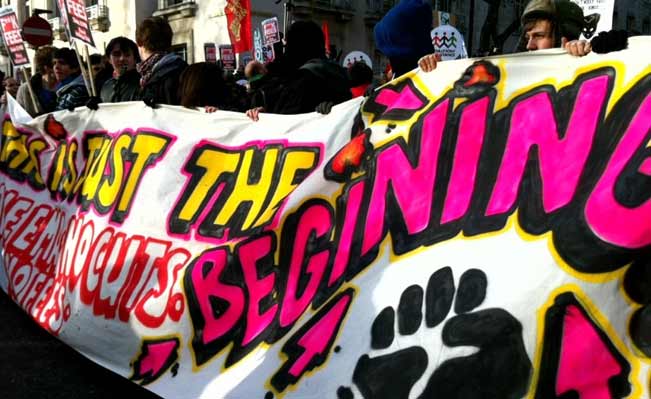
Neil Faulkner Archive | ETOL Main Page
Published online by Counterfire, 14 December 2010.
Copied with thanks from the Counterfire Website.
Marked up by Einde O’Callaghan for the Encyclopaedia of Trotskyism On-Line (ETOL).
Neil Faulkner looks at politics after the demonstration in Whitehall on 9 December and the implications for all those that seek radical social change.

|
As the light dimmed in Parliament Square on the afternoon of 9 December 2010, how many of the thousands kettled there realised they were making history? Here, before the world’s TV cameras, in an urban space dominated by the monumental architecture and bronze statuary of the British state, the drama of the democratic deficit was being acted out as if it were a carefully choreographed stage-performance.
On the far side of the square, in the neo-Gothic Victorian splendour of their Parliament building, the political representatives of the British ruling class were voting to triple university tuition-fees.
No-one had voted for this in the May 2010 general election – not even the massed ranks of the Tory-voting middle class – any more than they had they voted for the biggest package of cuts since the 1920s and the effective destruction of the postwar welfare state.
Even in relation to the Tories, there was no meaningful relationship between what politicians had said they stood for in May and what they were now proposing to do. But the case of the Liberal Democrats was worse. The Tories are, after all, the open party of the rich and big business; lying on behalf of their class is so deeply ingrained it is instinctive. The Lib-Dems, on the other hand, like to pose as a ‘progressive’ alternative, and the May 2010 general election had offered them a supreme opportunity to do so.
New Labour’s 13-year embrace of privatisation and the market, its endorsement of growing social inequality, and the nauseating way in which its suited career-politicians had sucked up to the rich and powerful, had opened a space on the mainstream centre-left into which Clegg manoeuvred his party.
It was undiluted opportunism. Clegg, like Cameron, is a millionaire from public school and Oxbridge. He belongs to the British ruling class: the 2% of millionaires and their families who cream off wealth created by the work of others in the form of executive salaries, fat-cat bonuses, and property portfolios. And he leads a thoroughly bourgeois party, unequivocally committed to British capitalism, its orange ‘radicalism’ mere election trail hocus-pocus.
Consequently, the formation of the Con-Dem Coalition was no mould-breaking transformation of British politics. It was a natural class alliance. But for millions who voted Liberal Democrat in May 2010, this has been a revelation.
Partly in response to their specific pledge not to increase tuition fees and a vaguer pledge to work towards the abolition of fees entirely, and partly because they talked in general as if they were the radical alternative to New Labour, almost half of student voters backed the Lib-Dems in May 2010. For these new voters, the shock of electoral betrayal has been extreme.
The ‘democratic deficit’ is no longer a hazy sense of lies and broken promises among older voters with low expectations. It is the visceral experience of young voters who enter the political process for the first time with their ideals and hopes intact, only to discover that they have been lied to and betrayed by a right-wing political elite that represents not ‘the people’, but the rich, the bankers, and their own tawdry careers.
But now something more has happened. On 9 December 2010, in the Battle of Parliament Square, the size of the democratic deficit was tripled. To grasp the significance of what happened on that day, we must review the month of mounting protest which preceded it.
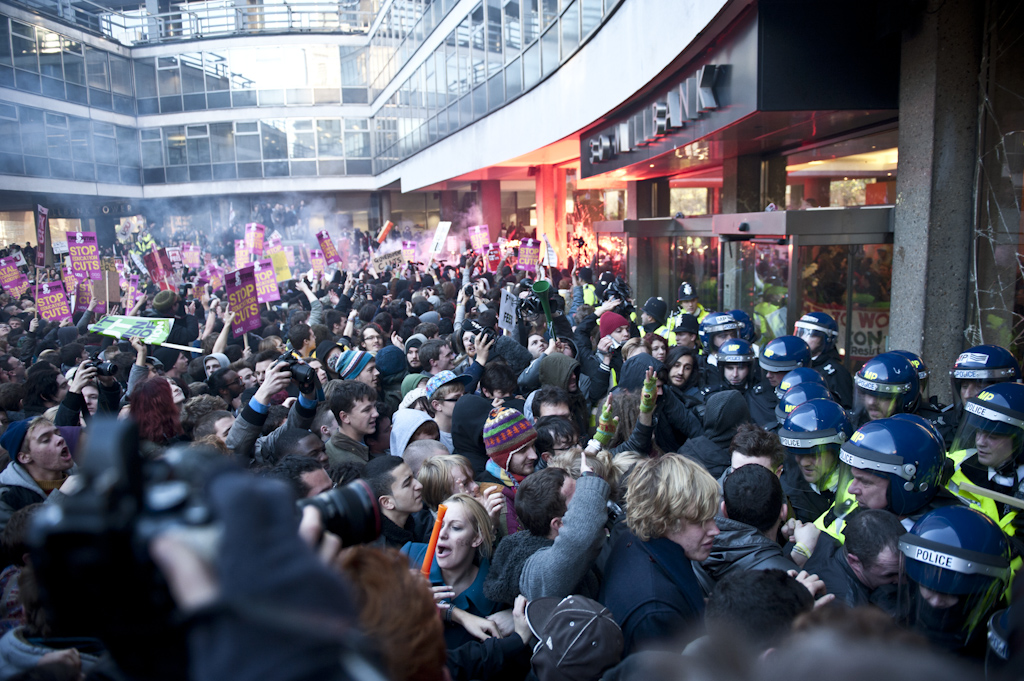
Protestors surround Tory HQ at Millbank: Image by Dougal Wallace |
Around 50,000 joined the official NUS march on 10 November, many arriving in fleets of coaches from provincial universities. Despite attempts by NUS officials to sabotage it, the feeder march from the University of London Union (ULU) attracted the support of thousands of the more militant students and set the tone for the demonstration as a whole. Attempts to canalise the march by NUS stewards and the police were defeated by surges across the road to fill the width of first the Strand, then Whitehall. At Millbank, the ground-floor lobby of the building where the Tory Party HQ is located was occupied and besieged. The militancy of this protest, which lasted for hours and involved several thousand students, surprised everyone.
The Millbank demonstration hit the headlines and launched a mass movement. Two weeks later, on 24 November, dubbed Day X-1, this time without any official NUS backing, a much bigger day of protest was organised by loosely structured anti-cuts groups heavily dependent on electronic social-networks. One estimate was that 130,000 participated across the country, including large numbers of school students, often walking out of school in uniform at an agreed time to join unofficial rallies. The main London demonstration, many thousands strong, was notable for its large school and FE college contingents. Kettled by the police at the lower end of Whitehall, many students fought back, and the day ended with police cavalry charges down the road.
A third day of protest – Day X-2 – was called for 30 November. This was the smallest mobilisation, but it is impossible to estimate numbers, since it was also the most chaotic. Without clear focus or proper stewarding, it dissolved into a series of surges, chases, and clashes across Central London as groups of students sought to avoid police attempts to kettle. In tandem, a wave of occupations was spreading across university campuses, typically involving between 50 and 100 active participants, but with much wider support in the student body as a whole. At its peak, in the run-up to the 9 December demonstration, there were occupations on 35 campuses, the main demand usually being that university management commit itself to opposing cuts and fee increases.

Students march on Grosvenor Square in 1968 |
The only real parallel with these events in Britain is the student revolt of the late Sixties. But there are major differences, and we are, in a sense, in uncharted territory. The size of the protests and the speed with which they have grown are unprecedented.
Eighteen months separated the first major protest of the last student revolt – the occupation of the London School of Economics in March 1967 – from what we now know was its highpoint – the Vietnam Solidarity Campaign demonstration of October 1968. There was a massive student turnout among the 100,000 who marched to the US Embassy in Grosvenor Square that day, with contingents thousands-strong from many of the major universities. Such, however, was the massive police presence that the protest ended with little more than ritual pushing and shoving.
How does this experience compare with that of the revolt which began on 10 November 2010? First, the relative number of students in the population is now much greater, with roughly four times as many university students today as in 1968. Second, because of this, a much higher proportion of students are from working-class backgrounds. Third, tens of thousands of school and FE students have participated in the recent protests, a level of mobilisation for this section of society which is quite unprecedented.
A heavy weight is harder to move, but once in motion, the momentum is greater. It is, in part, the greater social weight of students today that explains the extraordinary velocity of the movement. The density of students in society means that the infection of revolt can spread quickly from campus to campus. Electronic communication is an important facilitator, but it is not the cause. It makes no difference whether a call to arms is issued by leaflet, radio broadcast, or text-message: to be heeded, it must connect with a collective political will to act.
Today’s protests are different in another way, too. In the late Sixties, economic issues were secondary; it was political issues like racism and war that engendered the largest protests. This time, political issues form the backdrop to the revolt, but they do not drive it. There is anger about climate change, the war in Afghanistan, and the injustices of global capitalism. There is a decade of experience of mass protest over political issues, in particular against war, with 150,000 demonstrating against the Israeli attack on Gaza as recently as January 2009. But the student revolt is primarily a class-based movement against cuts and austerity.
It is fuelled by bitterness against the banks, the bailouts, and the corruption and greed at the top of society. It is a response to the political programme of a government of millionaires ruling in the interests of the City and the speculators of global finance. But it derives its real power from the fact that this is a make-or-break struggle to defend the material interests of ordinary people and the welfare state on which they depend.
Because of this, the potential for the student revolt to broaden and deepen, and for it to infect and draw into struggle wider masses of working people, is huge. There were trade union banners in Grosvenor Square in October 1968, but the workers were a minority. There was a partial disconnect between the political protests of students and the subsequent wave of working-class militancy which peaked in 1972 and brought down the Heath government in 1974 – a partial disconnect, that is, between political protest and economic strikes.
This time, an explosive fusion of student and worker revolt, of the protest politics of the street and the economic power of mass strikes, seems far more possible.
The Con-Dem Coalition has certainly created the conditions for combustion. It has launched a simultaneous attack on every section of the working class with the biggest programme of cuts since the 1920s. Cameron has bragged openly about ‘transforming Britain’ – destroying the welfare state and creating a new world of profit without welfare.
For the 80% of the population who belong to the working class – everyone from lecturers and teachers to the unemployed, everyone who depends on ordinary wages, pensions, or benefits, everyone who uses state schools, hospitals, and libraries – the Con-Dem cuts are a direct and immediate threat to livelihood and wellbeing. Every one of us has an interest in fighting back. The ruling class, cocky after a generation of almost unchallenged economic supremacy, is going for broke by taking us all on at once.
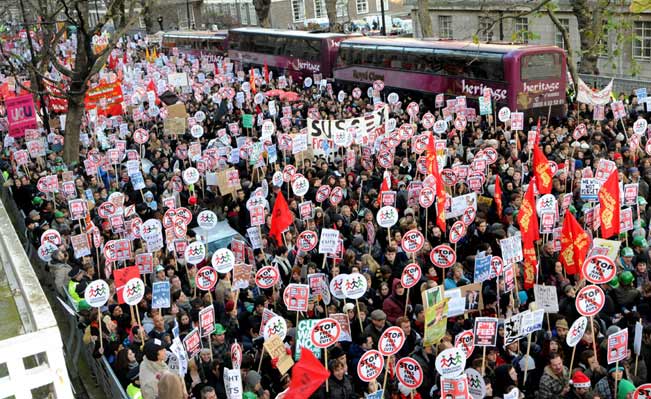
Protestors fill Malet Street as the march begins |
The historical possibilities opened by the 9 December demonstration are immense. Whether or not they can be realised depends on whether we use it as the launch-pad for a united mass movement of resistance from below. Many thousands, radicalised by the events of the last month, will want to try.
Hard lessons have been learnt. Day X-3 was the culmination of a month of protests designed to express anger and outrage at a denial of democracy. The argument was won. Why should students, already poor and in debt, pay more, far more, for the crisis of the bankers? How could such injustice be perpetrated when a fresh democratic mandate had just been delivered to do the very opposite? Surely the political system would punish liars and place-seekers like Clegg?
The scale of the shift in opinion as a result of the protests was clear. The Lib-Dems had dropped off a cliff in the polls. Their electoral support appeared to have at least halved. One YouGov survey put them on 8%:
You could see it on the faces of students watching the result of the vote in union bars. Many clearly believed Parliament would vote down the tuition-fee increase. Many were devastated when the result came through. There was no redress for Clegg’s betrayal. The system was not self-correcting. Parliament did not reflect the will of the people. Future students would face debts of £30,000 even though none of the electorate had voted for it
The political elite had just doubled the democratic deficit. Meantime, outside, it was being tripled.
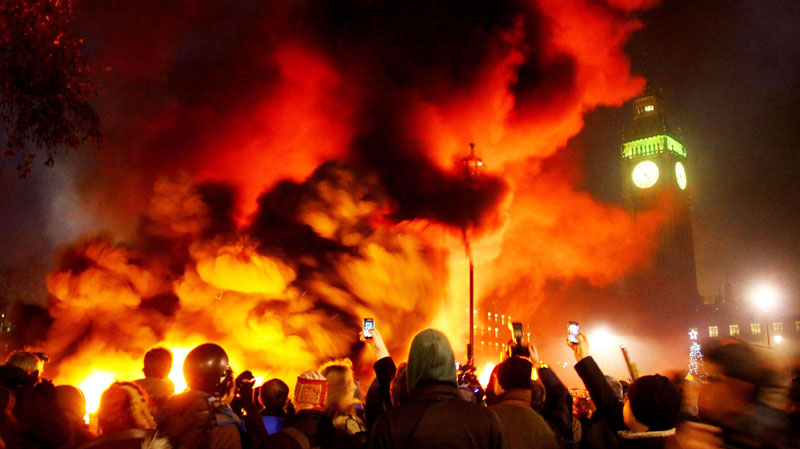
Fires burn outside parliament |
Tens of thousands of young protestors had already had their first taste of police violence. On 24 November, some thousands, most of them teenagers, many still at school, had been imprisoned for nine hours in the winter cold without water, food, or toilets. Many were on their first demonstration, and, attempting to exercise their presumed democratic right to protest, they found themselves trapped by hundreds of thugs threatening them with clubs. Meantime, other protestors further up Whitehall, demanding the release of those kettled, faced a series of cavalry charges.
Little wonder that few protestors trusted the police by the afternoon of the final demonstration. The NUS leadership, consistently spineless, had organised a rally and glow-stick ‘vigil’ on the Embankment and refused to support the main demonstration. (Later, it would send representatives into the TV studios to echo the ritual attacks of politicians and the police on the ‘violence’ of student demonstrators.) Parliament Square itself was cordoned off, save for the road on the northern side, down which the police wanted to funnel the demonstration, moving it away from Parliament and towards the Embankment. The political elite, meeting in Parliament to decide whether six-month-old election commitments were to be trashed at the behest of international finance capital, was to be insulated from the democratic protest outside.
Many protestors were not having it. At 2 o’clock, a crowd surged through the police line on the northern side of the square. Fifteen minutes later, they tore down the barriers around the green and occupied it. At 2.30pm, the police changed into riot gear.

Kettled on Westminster Bridge |
Parliament itself was cordoned off by double-width metal fences and lines of police on the eastern side of the square, and it was impossible to break through. A kettle began to form, fully in place by about 5.00pm, and there was frequent fighting at various points as protestors attempted to break out. At the height of the fighting, the Treasury building was attacked, with windows smashed and a rear door broken down.
Some protestors were not to be released from the ‘containment’ until almost midnight. By then, about 50 had been injured in successive cavalry and truncheon charges, one, 20-year-old philosophy student Alfie Meadows, with bleeding on the brain which required three-hour surgery. He could have been killed, either in Parliament Square, or when he arrived at the Chelsea and Westminster Hospital, where the police tried to stop him being treated (the paramedics ignored them).
First, Clegg lied about his intentions for tuition-fee increases and betrayed millions who had voted him. Then, Parliament made a travesty of the democratic process by ignoring electoral mandates, mass protests, and public opinion to vote the increases through. Finally, the state deployed 3,000 highly trained and heavily armed police to batter, intimidate, and penalise those who attempted to exercise their right to protest against this mockery. A triple whammy of political lying, parliamentary fraud, and police violence.
A hundred thousand young Britons, awakened to political action for the first time, have had a rich lesson in the nature of the modern state.
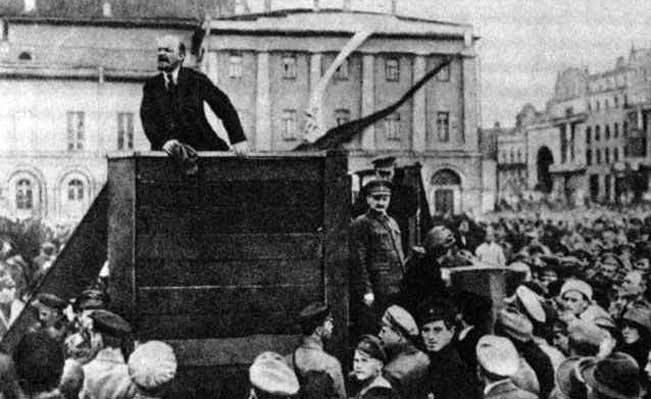
Lenin addressing a rally in 1920 |
Many may find it useful to read (or re-read) a revolutionary pamphlet published by Lenin, the leader of the Bolshevik Party, in the middle of the Russian Revolution in 1917.
Russia was between revolutionary insurrections when the pamphlet came out in August. The February insurrection had overthrown the Tsar and brought to power a Provisional Government of liberal and social democratic politicians. Lenin’s State and Revolution was a sharp polemic against those who believed that the existing state machine inherited from the Tsarist dictatorship could simply be taken over and turned into an instrument of social transformation. His central argument was that the state was not a neutral institution which could be used by whoever formed the government, but an instrument of class rule whose purpose was to protect the property and power of the rich. Because of this, he explained, the very essence of revolution was the overthrow of the existing class-based state, and its replacement by a new political system based on mass democracy.
Lenin’s theory of the state depended on four critical propositions:
The full text of Lenin’s State and Revolution can be found at www.marxists.org/archive/lenin/works/1917/staterev
The power of protest – of direct action and direct democracy – has already created a political crisis for the Con-Dem regime. It has forced the Tories to make some concessions on tuition fees. They are paltry, but the fact of them gives us a glimpse of our power and the regime’s fear. The Liberal Democrat electoral base is in meltdown, and its MPs split three ways in Parliament, 28 voting with Clegg, 21 against, and five abstaining. The scale of the parliamentary revolt cut the Con-Dem majority to just 21. Had a mere 11 more MPs joined the revolt, the government would have been defeated.
The New Labour ‘opposition’ has also been shaken up by the student protests. Ed Milliband and Alan Johnston have been bickering about their preferred alternative to tuition-fee hikes, while Aaron Porter, the New Labour President of NUS, wobbles between endorsing direct action on university campuses under pressure from his own membership to organising farcical stunts like the glow-stick vigil as an alternative to serious mass protest.
We should be in no doubt: this crisis for the political class has nothing to do with the corrupt and sclerotic routines of parliamentary politics – it is a direct result of the protests.
The 9 December was the end of the beginning: the end of the first phase of what looks set to become a wave of mass struggle from below in the years ahead. The historical stakes are very high: nothing less than the survival of the welfare state. The British ruling class aims to use the cuts to privatise the universities, marketise the NHS, destroy the comprehensive system, and slash benefits and pensions. They aim to restore the finances of the state at our expense, so that they can continue to bail out the banks and big business. They aim to keep the world safe for profit and greed, so that the rich can continue getting richer. And, at the same time, if we let them, they will fight new wars for oil and power, while the planet burns and poor countries starve.
Because the stakes are so high, we face a long, hard struggle. We are going to have to build sustainable networks of democratic assemblies and activist groups to organise that struggle, and we must plan for a mounting wave of demonstrations and direct action powerful enough to stop the cuts, make Britain ungovernable for the ruling class, and drive the Con-Dem Coalition of millionaires from office.
The London Student Assembly is a superb model. With up to 200 student activists from across the capital attending weekly meetings at ULU, it has become the direct expression of the democratic will of rank-and-file students in struggle. This example should be replicated in campuses and cities across Britain to create a national network of student assemblies. This can provide the solid organisational base for a renewal of the struggle next term.
The immediate focus is likely to shift to the campuses themselves. Here, we should raise clear demands, agitate to win a majority of students to them, create links with campus workers, and then fight to impose them on school, college, and university managements:
At the same time, the student movement should be making links with the unions and the workers at a rank-and-file level, and putting as much pressure as possible on the union bureaucracies to lead action and solidarity. The students should not be left to fight alone. Their battle is everyone’s battle. The police can batter and kettle 50,000 students; it would be a different matter if they faced 500,000 workers. Those who head the unions have a responsibility to lead them into action and deploy their power on the side of the resistance.
We must seek to fuse three elements in the struggle: mass protest, democratic organisation, and clear demands based on a radical vision of an alternative society. If we do this, we can deepen and broaden the popular revolt, drawing in larger numbers, spreading it to other sections of society, and beginning to accumulate the political forces necessary to win.
Students marching into Parliament Square on 9 December carried a banner inscribed ‘This is only the beginning’. Marching out of the police kettle eight hours later, they chanted ‘We’ll be back!’
We must now make it so.
Neil Faulkner Archive | ETOL Main Page
Last updated on: 13 February 2022